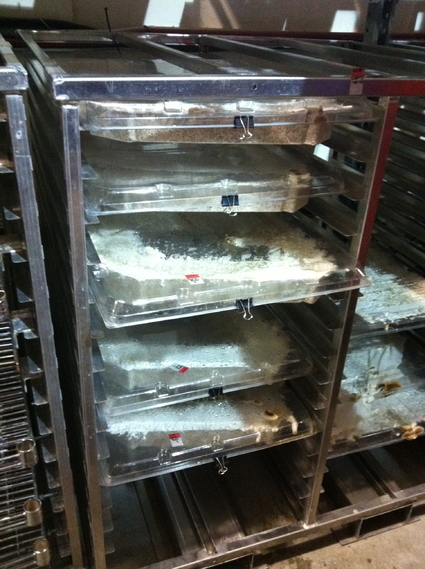In the words of Paul Stamets, 'mushrooms can save the world', and there's no better place to see these world saving powers than in a tucked away industrial area in Green Island, New York. With the goal of replacing everything from petroleum based plastics (like Styrofoam) to particle board (which is made using carcinogenic formaldehyde) with a renewable mycelium based material, Ecovative is harnessing all the world saving possibilities of the mushroom. Eben Bayer, the CEO of Ecovative, took us on a little tour of this rapidly expanding facility.
The Process
Having only seen the finished mycelium based materials, and some experimental prototypes, I was really excited and curious to see the whole process of making, or rather growing, this innovative material on a much larger industrial scale.
The process begins with the collection of agricultural products, which come by the truckload from farms in the region. Each material requires its own unique mix of agricultural waste products, depending on its density, weight, and use.
The material then goes through a steam pasteurization system which gets rid of any mold or contamination. Eben told us that the machine used to do this originally came from an old chocolate chip factory, and they re-made it into a patented pasteurizing machine.

Looking around the factory, these 'frankenstein' machines are a common sight, with young employees building and experimenting with new machine designs using recycled materials, including bicycle wheels.
Once the substrate (the agricultural waste base on which the mycelium will grow) is pasteurized, it is inoculated with mycelium in a clean room, and molded into a form.

These molded forms are put on racks indoors for about a week while the mycelium grows through the substrate.

In the final step, the parts are popped out of their molds and dried in order to stop the growth. Ecovative Sample Materials - Sample molds and packaging materials on the shelves at Ecovative.

New Factory

Arriving at a transitional time for the company, I was able to see the new, and much bigger, factory space across the street that Ecovative was just in the process of moving into. They are keeping their original space as a place to focus on research and development and design, but moving all industrial production into the new factory.
Research and development.
What began as a biodegradable replacement for polystyrene, that one-use packing material which uses vats of oil to produce and sits in landfills for millions of years, has now grown to become a potential replacement for many plastic based materials.
At the Ecovative factory they are constantly experimenting with new kinds of fungus and working on pilot projects proposed to them by some very big companies. They have even teamed up with Ford to develop car bumpers and other car parts out of mycelium based materials, which you can read all about here. Many of their projects are in the experimental phases, and are still top secret, so I can't spill any information here, but trust me that there are some amazing projects brewing in the research lab. The newest issue of Wired has a very indepth article about Ecovative, and further proves what the director of Mediamatic has been saying all along, that mushrooms are the new new media.
Find out everything that Ecovative is up to on their website, and if you ever find yourself in Green Island, NY, you can even go on a little tour yourself.
